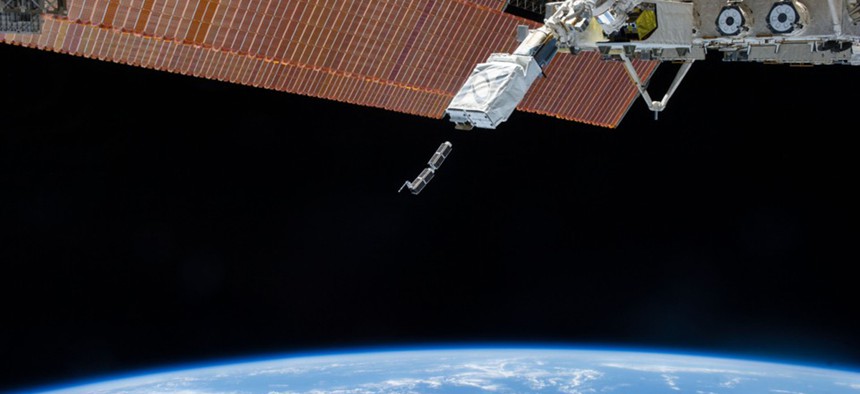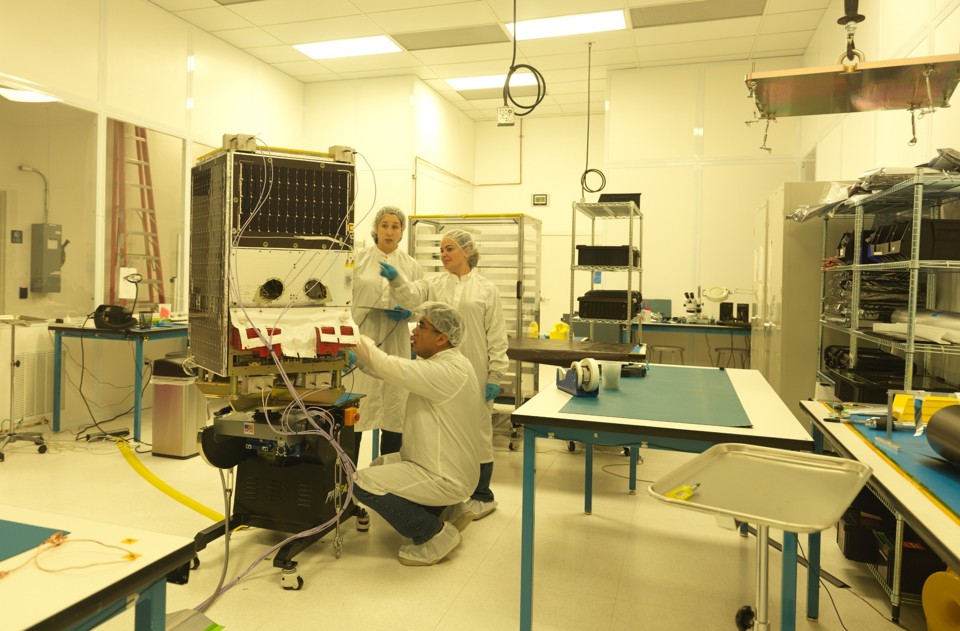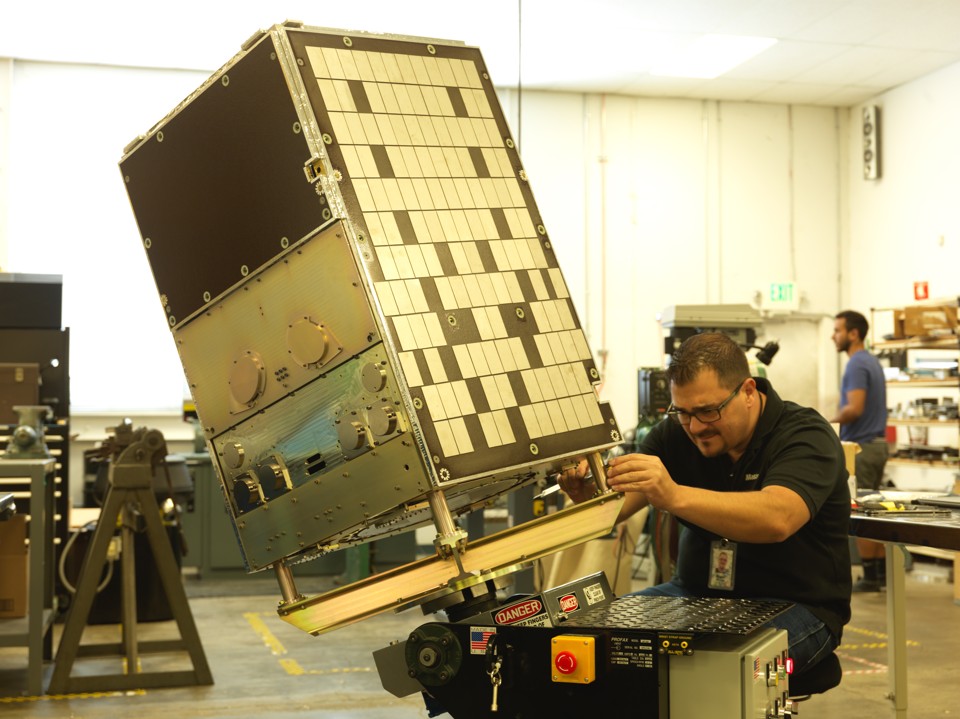A New 50-Trillion-Pixel Image of Earth, Every Day

The International Space Station releases early Planet Labs satellites in February 2014. NASA
Thanks to a small group of Silicon Valley’s satellite startups, we may never look at our planet again the same way.
MOUNTAIN VIEW, Calif.—It’s not just that Terra Bella Avenue would be an unremarkable street in Silicon Valley. It would be an unremarkable street anywhere in suburban America. The gray-brick low rises could sit at an intersection in Edison, New Jersey, or Skokie, Illinois, real-estate attorneys or school-district administrators shuffling in and out every day, and nothing would seem out of the ordinary.
But inside one of these buildings, past the cubicles and office kitchen, is a space-grade clean room where a man and woman are dusting off a new satellite the size of a dorm-room fridge. They’re clad in white, and their workspace resembles at once an auto shop, a high-school robotics lab, and the kind of gleaming NASA warehouses you see on the Discovery Channel.
And in the next building over, a mission-control center dictates directions to two camera-laden spacecraft as they travel up and down the Earth, from pole to pole, every 90 minutes. With the help of relay towers in Norway, Alaska and Antarctica, technicians download new imagery and monitor solar radiation through an “instrument panel” inside a Google Chrome window. Behind their hanging array of screens, there are seats for operators during launch and activation—each terminal just an Apple monitor and a Mac Mini.
And all of this beneath industrial tile ceiling.
This is the home of Terra Bella—the satellite company, formerly known as Skybox, that Google purchased for $500 million in June 2014. In the next 18 months, it plans to put more than a dozen new satellites into orbit. This will increase its imagery “refresh rate”—that is, how often any one spot on Earth is photographed—from one new image every three days to four to five new images per day.
Terra Bella is part of a larger group of satellite companies that promise to transform the way we see Earth. Planet Labs is another: An independent startup based in San Francisco, it estimates that in the next 12 months, it will have more than 100 satellites beaming imagery down to Earth. That will give it an almost-daily imagery refresh rate. Twelve of those satellites are due to slip into orbit this Thursday, care of astronauts on the International Space Station.
More than two years ago, I looked at a class of startups that I said were making “Silicon Valley’s new spy satellites.” They were, at heart, technology companies of 2010s vintage: funded with venture capital, well-versed in simulating hardware with software, and comfortable with “the cloud” and all its metaphors of scale. But they were also space companies, committed to building custom machinery and getting it into orbit.
The profile of many of these organizations has grown since. Terra Bella has, of course, joined Alphabet. Planet Labs, which was flying just two test “doves” then, commands more than 35 now. Analysis companies, including Descartes Labs and Orbital Insight, have also sprouted up around the new bounty of imagery.
But however much they’ve expanded so far, the coming year will be decisive for many of these firms. By the summer of 2017, many promise daily or more-than-daily refresh rates. Within a few years, hundreds of Earth-observing satellites could float above the planet, each little more than a camera at the end of a massive (and affordable) chain of processing, computing, and distribution.
Or something could break: The market could falter, a couple key investments could dry up, and remote-sensing technology could be stuck at its current spot for another decade.
* * *

There are more than a couple new-ish companies in the satellite industry. Urthecast, for instance, operates a high-definition camera on the Russian part of the International Space Station; the Vancouver-based corporation purchased two imagery satellites last year and says 16 more are on the way. Black Sky Global, a startup in Seattle that definitely doesn’t have an ominous name, says it plans to have 60 satellites operating by 2019. Other companies remain in “stealth mode,” meaning they’ve been founded but haven’t announced anything yet.
Even DigitalGlobe, the leader in the field, is building six smaller satellites with the help of the Saudi government to boost its refresh rate. Right now, DigitalGlobe (and to a lesser extent, Airbus) rules the business: When you look at pictures of your house on Google or Apple Maps, or when the Red Cross uses satellites pictures to do emergency-relief mapping, you’re seeing DG imagery.
But it’s Planet Labs and Terra Bella who seem to be driving the small-satellite industry. Both are born of and based in Bay Area business culture. (Terra Bella’s founders often speak of the Stanford class where they met.) Both companies are now non-negligible in size: Planet Labs has more than 330 employees, evenly split between space-operations and product engineering; Terra Bella numbers more than 180. For reference, DigitalGlobe employs 1,300 people.
And, despite both manufacturing satellites, Planet Labs and Terra Bella both downplay their importance. Dan Berkenstock, Terra Bella’s CEO, even implied its why the company is changing its name:
“I think Skybox, in many ways, came to be equated with satellite imaging,” he told me. “And satellite imaging is great—but that’s one piece of the puzzle.” (I also wonder if Skybox sounded too much like the similarly geospatial-minded Mapbox or the recently devalued Dropbox.)
Instead, both companies now talk about how imagery fits into their “Earth information platforms” that bring together lots of different kinds of data about the planet. Both companies offer APIs, aiming to provide something like “cloud” services for Earth information. (As opposed to “cloud” services for the Earth—that would be something else entirely.) Both companies are also cagey about what kind of non-imagery data could get included in these platforms, but meteorological and climate data would make sense.
“The product is information processing—real-time, fact-based data,” says Robbie Schlinger, co-founder of Planet Labs.
For Terra Bella, the uses of its eventual platform revolve around “economic transparency.” Their satellites have sufficiently high resolution to see vehicles, and they record high-definition video, not still frames. They mention executives working on logistics problems, or people checking on a construction project far away, when discussing their project. Their satellites’ resolution also puts a solution to “the Walmart parking-lot problem” in reach: an almost-infamous idea that financiers could scry the direction of the U.S. economy by tabulating how many cars obscure the blacktops of the nation’s big-box retailer.
Planet Labs tends to focus on different situations. As recently as last summer, it was a “unicorn,” valued at more than $1 billion. And unlike Terra Bella, which has leased out some of its manufacturing, Planet Labs still builds all of its extra-large Cubesats in its South of Market headquarters in San Francisco. Next month, the company will begin constructing 120 of them in a six-week span, the fastest manufacture of satellites in history, according to Schlinger.
Its satellites are a better fit for observing land use: the health and types of agricultural crops, the extent of logging and deforestation, the availability of water and the plumpness of reservoirs. (You can still often discern car and truck-sized objects in its photos.) Last year, it started giving imagery of newsworthy areas, like the Syria-Turkey border, to outlets like The New York Times.

Planet Labs also works with outside firms that use computers and machine-learning algorithms to watch crops and land changes. For a long time, such analytical work had required human experts. These companies include Descartes Labs, whose programmatic predictions of annual corn yield have proved more accurate than the USDA’s. (In August, a Bloomberg News story about Descartes’s estimates moved the national corn market by 3 percent.) Planet Labs also works with more farmer-focused services like FarmLogs and FarmersEdge.
Planet Labs will also soon be able to do some basic analysis by itself. The next version of its software will let users do one-click change analysis across different imagery, seeing roads, towns, and other major features that weren’t there a week, month, or year before. For many decades, even that most basic of techniques was only available to intelligence agencies, and it could require hours of expert analysis. Now it’s a toggle switch.
Planet Labs says it has more than 400 customers and is not yet profitable. And at some point between when its 100th and 200th satellite enter orbit, it says it will finally achieve a long-sought after goal in the industry: It will have an image of every spot on the globe, updated at least once every day. This roughly 50-trillion-pixel portrait of Earth, daily made anew, will serve as both an incredibly valuable data resource for humanity and as Planet Labs’ flagship product.
Schlinger and his co-founders are betting that new imagery of everywhere, every day, is a nearly incomparable service, orders of magnitude more useful than the industry’s current regime, which can be described as “new imagery, of some places, occasionally.” Terra Bella talks in similar terms: Its founders see the approaching advent of the daily refresh-rate as something with so many technological applications as to be almost unfathomable. They compare it to the emergence of civilian GPS in the 1990s: At first, it was so obviously useful that nobody knew how to use it.

And they’re right. It’s difficult to anticipate how such a service will alter our world, even if at first it’s only available to financial firms. So I asked Schlinger to imagine one possible implementation.
“The tides are changing on greenhouse-gas emissions, deforestation, and agricultural land use,” he told me. Planet Labs might attain its goal at the right time to help. With its all-imagery-everywhere service, the company could initiate or assist with “a global measuring and verification system for carbon,” he said.
By combining images of noticeable economic activity—and all major land change—such a program could be a “definitive, factual, unbiased account of the world’s carbon system.” Its database could then help arbitrate an international cap-and-trade scheme or another global carbon-pricing system.
Schlinger has other ideas for the data, too: He hopes that, eventually, cheap, civilian-grade satellite imagery can be made available to all arms of the government at once, and not just its intelligence apparatus. In the United States, humanitarian and environmental organizations can sometimes only receive satellite photography once spooks have signed off on it, a process that can slow time-sensitive applications like disaster response. Planet Labs—or another daily-refresh firm—could change that.
* * *
Recently, certain types of people—venture capitalists, convention-hall exhibitioners, and think-tank soothsayers—have talked of a “space renaissance.” There’s even a bill with that name currently under consideration in Congress. All these folks aren’t wrong: Inexpensive hardware, advances in software, and more frequent rocket launches really have made it much cheaper to hurl something into orbit. The White House, apparently preparing for hundreds of new civilian satellites this decade, has indicated it might move orbital air-traffic control from the Air Force to the Federal Aviation Administration.
Satellite imagery will not be the last outer-space enterprise altered by these changes, but it will be one of the businesses where we most feel their consequences. Low-earth orbit is the best, cheapest place to put a camera and fit millions of folks into the frame. If Planet Labs and Terra Bella succeed, satellite imagery will be even more plentiful than it is now, and many of us will learn new ways to think through scale, distance, and completeness. And, I suspect, we will come to learn too that being able to see something doesn’t mean you can do anything about it.






